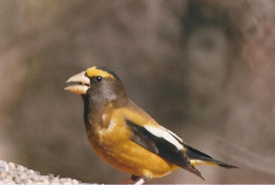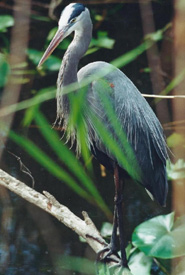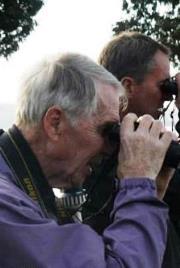Birds of the Happy Valley Forest (Part Five)

Evening grosbeak (Photo by Anna Tchoulik)
Our forest cover in the Happy Valley begins a few miles above the lakeshore of Lake Ontario. Birds stop here each year to feed and rest while on their migration north in the spring, and as a last stop in the fall as they move south. In the fall they head for southern United States, Mexico, Central and South America. Some species go as far as the Pampas of southern Argentina and southern Chile.
Ducks and geese do not tend to migrate the great distances of most migratory land birds. They crowd open water spaces such as the Great Lakes and may be seen in running streams. Of course they appear in large numbers at Chesapeake Bay in the U.S.
The Arctic tern is an extraordinary migrant species. From its breeding grounds in the high Arctic it crosses to the eastern Atlantic, following its shores to feed in the offshore waters along the western coast of Europe to the southern African waters where it winters, feeding for its long journey back to Alaska, Canada and Siberia.
Each winter the Canadian fields and forests, including the Happy Valley Forest, are invaded by high Arctic and some boreal forest breeders, including:
- American three-toed woodpecker
- black backed woodpecker
- pine and evening grosbeak
- snow bunting
- both red- and white-winged crossbill
- Lapland longspur
- pine siskin
- rough-legged hawk
All of these species appear but the time of their arrival cannot be predicted. Most usually it is in November.
Some of these wintering birds stay back on and below the Oak Ridges moraine to feed and rest: rusty blackbirds, pine grosbeaks and pine siskins are common examples that may return to the Happy Valley Forest and, when appropriate to their diets, my feeder.
The fall migration includes larger flocks than seen in the spring (they have raised families, of course). Pine siskins, snow buntings, American pipits and horned larks are examples. The shorebirds nesting on the tundra tend to form the largest flocks and seem in no hurry to leave. Most gather in eastern Canadian beaches, our sewage lagoons, at times our open fields and some on the edge of the ponds and lakes of the Happy Valley Forest.
Swans and herons

Great blue heron in breeding plumage in the Happy Valley Forest. (Photo by Dr. Henry Barnett)
The tundra swan is the pièce de résistance of Canada’s Arctic. It nests on the tundra, has migratory resting spots in the St. Lawrence River near Quebec City at Cap Tourmente and winters in Chesapeake Bay. It will drop by farmer’s fields and ponds in King Township to feed and rest up on route.
Nowadays it may be accompanied by trumpeter swans. The trumpeter gives a clarion call en route to its nesting sites. Three species of swan now migrate through and nest in Canada.
The great blue heron nested in the Pottageville swamp of the Happy Valley Forest until 20 years ago. By that time the elm trees holding the nest had died and the trees had fallen away, carrying the nests to their destruction. In recent years younger trees are supporting smaller but viable herons’ nests. In one or two places, great white herons cohabit. Green herons share the nesting areas near water, including vernal pools.
This is the eighth in a series of blog posts Dr. Barnett will be contributing to Land Lines in the next few months.


